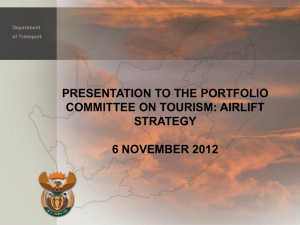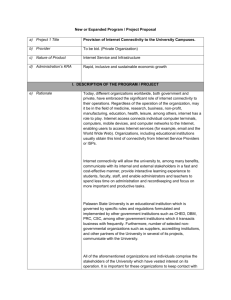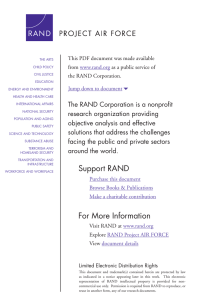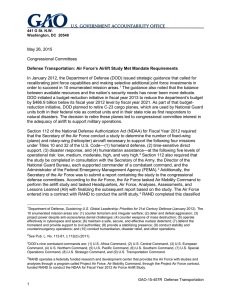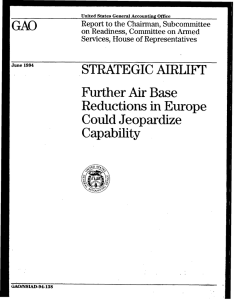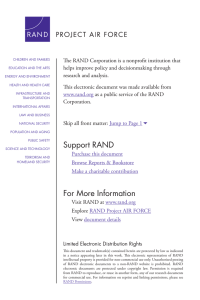Department of Transport
advertisement
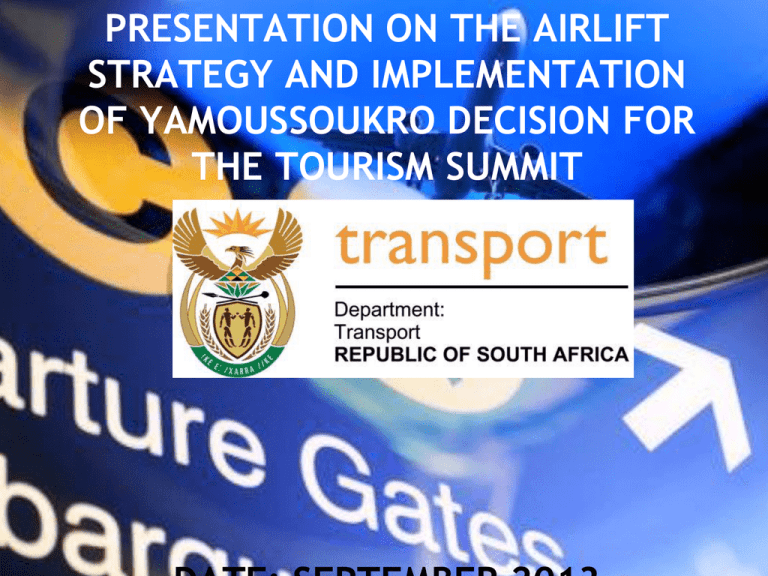
PRESENTATION ON THE AIRLIFT STRATEGY AND IMPLEMENTATION OF YAMOUSSOUKRO DECISION FOR THE TOURISM SUMMIT TABLE OF CONTENTS Section 1 IMPORTANCE OF CONNECTIVITY Section 2 AIRLIFT STRATEGY ENHANCING CONNECTIVITY Section 3 WHAT IS YAMOUSSOUKRO DECISION AND WHY IS IT IMPORTANT Section 4 STATUS QUO Section 5 CHALLENGES/ISSUES IMPORTANCE OF CONNECTIVITY Connectivity is increasingly important to the global economy; Connectivity is important for the ability connect people and to move goods quickly, reliably, and at a reasonable price; Connectivity is key for tourism; Increased regional consultation and decision-making for matters of air transport. AIRLIFT STRATEGY ENHANCING CONNECTIVITY Increasing contribution to accelerated economic growth; Increase the mobility of the domestic market; Improve Safety and Security; Aviation Community well-being; and Environmental responsibility AIRLIFT STRATEGY ENHANCING CONNECTIVITY continue……. Improve relationship and partnership between states, stakeholders, industry and government moving towards shaping the air transport system as well as expanding the low cost carrier concept within South Africa; Increase useage of aviation facilities in the country Increased granting of 5th Freedom traffic rights; Establishment and strengthening of regional civil aviation WHAT IS YD AND WHY IS IT IMPORTANT Successor to the Yamoussoukro Declaration on a New Air Transport Policy in Africa adopted in 1999; Adopted in 1999 and endorsed in 2000 as a Decision of the Assembly of the African Union within the context of the Treaty establishing the African Economic Community(Abuja Treaty); WHAT IS YD AND WHY IT IS IMPORTANT Focus on internal market liberalisation and fair competition as a key development strategy while also addressing safety, security and environmental issues; Complete implementation initially was envisaged within two(2) years and was subsequently, revised to 2006; and To-date implementation target is yet to be attained by most of the African States STATUS QUO Since the inception of the Airlift Strategy which incorporated the mandate to implement key elements of YD with willing States pending the multilateral implementation, the Department of Transport in 2010 reviewed bilateral air services arrangements with the following countries in an attempt to increase traffic frequencies : ● France ● United Kingdom ● India ● Japan ● New Zealand ● UAE ● Korea ● Australia ● Nigeria ● Brazil ● Netherlands ● Kenya ● Cameroon ● Senegal CAPACITY INCREASES The Department of Transport continued to implement the Airlift Strategy and created capacity in air traffic increases as follows: S America: 2008 2009 2010 2011 2012 2013 Brazil 14 21 28 Europe: France 14 UK 56 63 Netherlands 23 30 35 Luxembourg 7 Ukraine 7 CAPACITY INCREASES AFRICA: 2008 Senegal YD Kenya YD Cameroon YD Nigeria 10 Botswana Burkina Faso Burundi 2009 YD YD YD 2010 YD YD YD 2011 10 YD YD 2012 2013 CAPACITY INCREASES AFRICA: 2008 Eritrea Mozambique Mali DRC Nigeria Tanzania Seychelles 2009 2010 2011 2012 YD Seats YD 9 13 2013 28 YD CAPACITY INCREASES ASIA: 2008 Japan 7 Korea 15 Australia 10 New Zealand 7 India 14 Pakistan Singapore China Viet Nam 2009 2010 2011 2012 2013 15 14 21 21 28 7 17 14 7 CAPACITY INCREASE ASIA: Sri Lanka Maldives 2008 Middle East: UAE 42 2009 2010 2011 7 2012 7 54 63 2013 NEW POINTS OF ENTRY With all the bilateral air services arrangements reviewed, points of entry to/from South Africa were opened up except for States within Europe due to the pending finalization of South African position on matters related to Horizontal Agreement and single designation. Only 55% of the bilateral have been taken hence the principle of use it or loose it. FEARS AND CHALLENGES Poor connectivity; Reduced competitiveness and quality of services on intra -African routes; High cost of air travel; Insignificant impact on socio-economic development of majority of African populations. CHALLENGES continue… Differences strategies; in macro-economic policies and Different levels of development and deep concerns of individual country/state interests; Fear of the unknown: lack of knowledge on the actual/expected benefits and/or negative effects of liberalisation; CHALLENGES continue……. Market position / competitive advantage; The Executing Agency; Competition regulations; Dispute settlement mechanism; Appropriate policy on relations with third parties. POSSIBLE BARRIERS Negative Experience Difficulty of seamless travel Safety and Security YD Unfavourable bilaterals THANK YOU

